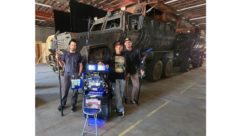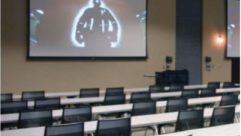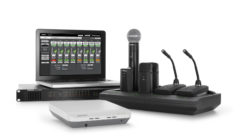

AV as Utility? Not Very Likely
Over the past few weeks I’ve been tracking a little dust-up between Nicholas Carr and the readers of Network World magazine.
Over the past few weeks I’ve been tracking a little dust-up between Nicholas Carr and the readers of
Network World
magazine. Carr, the author of a controversial 2003
Harvard Business Review
article “Does IT Matter?,” recently published a book called “The Big Switch: Rewiring the World from Edison to Google.” I haven’t read it (yet), but a review in
Network World
stirred up a hornet’s nest among IT managers.
In short, Carr believes that much of the work done by large IT departments will eventually be out-sourced, replaced by so-called “utility computing.” He believes that “business units and even individual employees will be able to control the processing of information directly, without the need for legions of technical people.”
What does this mean for our industry? The answer depends on how deeply the idea of convergence takes hold and, even, on what we mean by convergence. At the extreme end are concerns that IT departments will eventually absorb AV responsibilities and staff, regardless of how well they understand the nature of AV and its inherent differences. Then, if there is no longer an in-house IT, whither AV? If IT can be outsourced, what does that say for AV services in the corporate world or in higher education? What impact will this have, not only on design services, but installation, maintenance, and operations? If Carr’s vision for IT is true, can the AV world be far behind?
HOLD THE PHONE
Not necessarily. In Carr’s view, computing power is analogous to electrical power—predominantly hardware. Computers have become more of a commodity, much like electrical distribution systems and power outlets. GE and Westinghouse are no longer in the power generation business and now provide other services in related fields. IT will follow the same route, according to Carr.
But there are plenty of issues that could hinder the prospect of utility computing. To name a few: network and computer security; the need for customization of applications; whether the network and network services are truly utilities or mission critical; an institution’s comfort level with placing information in the hands of an outside entity; and access to privileged information.
So how valid would a utility model be in the AV world? Just look at the reality behind the electricity analogy. In spite of Carr’s claims to the contrary, GE and Westinghouse are still heavily involved in the design of such power generation systems as nuclear and wind powers. Plus, there remains a need for local power generation or co-generation plants suited to the specific needs of a particular industry or business. Engineering and consulting have not disappeared—they have shifted to areas of greater need.
As convergence and utility computing trends touch AV, change may similarly be for the better, but not as drastic as Carr envisions for IT. Using a common infrastructure promises to reduce installation and operational costs, and network-connected AV appliances make a lot of sense to owner, operator, and integrator.
The primary applications are in the management and control of audio systems, as well as the monitoring of control systems. With the advent of DSPs, networked audio systems, and IT/IP connectivity, the ability to monitor and control large systems is viable. For contractors responsible for post-installation support, this can provide a major cost savings when they cannot place someone at the site full time. The ability to remotely troubleshoot issues can save time and money in service calls. Audio manufacturers are moving in this direction; Harman Pro’s HiQnet integrated software systems is example. On the control side, AMX and Crestron certainly have remote capability.
Granted, I don’t think many owners have extended remote capabilities beyond the walls of the institutional network for a variety of reasons, from whether the audio and control systems use the same network infrastructure as the corporate to whether IT management will give an outside vendor access to their network. If audio and control systems were on separate switching and routing fabrics, you might get an IT manager to allow the necessary access.
WHY AV PROS ARE KEY
But regardless of IT convergence and utility computing, I’m continually reminded that our industry employs technology to improve communications. We help people see, hear, and interact with each other as they conduct business, instruct, or heal. Our jobs involve reducing the filters that separate people by distance, time, or technology. That will require a great deal of research, engineering, design, installation, and operational skills for years to come.
UPDATE
White Space Redux
Here’s an update on the white spaces kerfuffle in my anxiety closet (February, page 90). The initial bids for the first set of frequencies (in the 700MHz band) are in. However, the issues discussed in last month’s article have yet to be adequately addressed.
The FCC began its second round of testing on interference detection technologies in February. According to Morningstar.com, Microsoft’s second device failed this round of testing, though four other companies, including Motorola, are submitting devices for testing. For our industry, the sooner this testing is completed, the sooner we’ll know exactly what the rules will be, which will allow the pro audio wireless systems manufacturers to create new products.
Communications Daily reported in January that there could have been a delay of up to a year. While the White Space Coalition was pushing Congress to make the FCC move faster, “the FCC … [had] been criticized for moving too fast to change the rules regarding co-ownership of radio, TV, and newspapers.” It appears that white space devices could show up on the market sometime in 2009, but probably not in time for the Feb. 19, 2009, change.
I’m also reminded of Arthur C. Clarke’s Third Law: Any sufficiently advanced technology is indistinguishable from magic. There is a little stated corollary that the more magical a system appears, the costlier it will be. Programming of a control system or a video routing system becomes more involved and costly as the system’s desired transparency or simplicity increases.
And as far as we have come over the last 20 years in creating standards and best practices, we still have a long way to go. Much of our work still requires some degree of customization, if only to meet the needs of the client. Software and hardware systems do not play well together; it’s almost impossible to get agreement on how a GUI should look, much less how different systems should work together.
I think this is the issue Carr fails to understand fully. While much of what he sees in the IT industry appears easy, it is not. In the AV industry, it’s less easy. I’m reminded of the Army Corps of Engineers’ motto during World War II: “With willing hearts and skillful hands, the difficult we do at once; the impossible takes a bit longer.” This will take a bit longer.
Thom Mullins is a senior consultant with BRC Acoustics & Technology Consulting in Seattle. He can be reached at [email protected].










